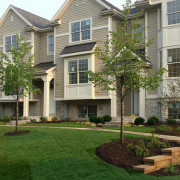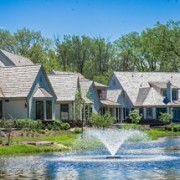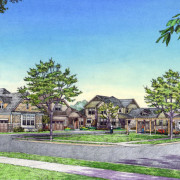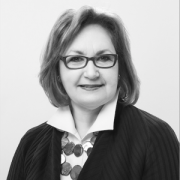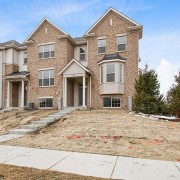Edward R. James Companies proudly announced that residents have begun moving into its 29-unit townhome community, Brighton Mews. Read more in the Chicago Tribune about the remaining opportunities to buy an Edward R. James townhome in the heart of Park Ridge.
Edward R. James Companies is proud to announce it’s received two Gold Key Awards from the Homebuilders Association of Greater Chicago!
In the second of Chicago Agent’s five-part series, “Developing Chicago,” Jerry S. James, president of Edward R. James Companies, describes what he sees as an emerging trend in the Chicago area’s new-construction housing market.
See what Edward R. James Companies President Jerry S. James has to say about the state of new construction in Chicago realestate, and why niche markets are seeing activity, particularly in the NorthShore.
Fox Business Network Correspondent, Jeff Flock spoke to Edward R. James Companies’ president Jerry S. James this morning to discuss the housing market and what’s ahead for both builders and homebuyers. Westgate at The Glen in #Glenview was the perfect spot to conduct these three interviews, because the outlook is positive!
Jerry James, president of Edward R. James Companies, tells Builder Magazine how communities facing military base closure can use The Glen, located in the Village of Glenview, as a case study in how careful planning and construction can convert a base closure into an economic engine rather than an economic blow.
Check out Edward R. James Companies’ very own Priscilla Schumacher in Chicago Agent Magazine, describing the top four ways homebuyers can downsize space – not lifestyle.
By Jennifer Goodman
(Intro) Baby boomers are the largest part of the population in America, and have also been leading the charge in the housing market’s recovery. In fact, according to a recent survey by Merrill Lynch, 64% of retirees say they are likely to move at least once during retirement.
However, unlike older buyers of a generation ago, today many are opting to stay in the workforce and in the city where they built their career while seeking greater flexibility in lifestyle and design. To meet the changing needs of this demographic, home builders outside of the Sunbelt states are getting creative.
According to Jerry S. James, president of Glenview, Ill.-based Edward R. James Homes, staying connected to the important people in their lives is a key consideration for empty-nesters when choosing a new-construction home, with many buyers looking for a smaller home within proximity to their current location.
By Dennis Rodkin, Crain’s Chicago
While many of their empty-nester friends have swapped suburban houses for condos downtown, Susan and Butch Honaker opted to stay in Northfield. They had owned a house on an acre of land for 32 years, and in January they moved into a newly built house 2 miles away.
“We still want the trees and the yard and the patio,” says Susan Honaker, whose husband recently retired from Goldman Sachs. “We’re changing our lifestyle but we didn’t want to let go of the comfort we feel in Northfield.” Staying in the same town kept them close to their preferred shops, restaurants, clubs and doctors.
Seniors like the Honakers are a hot market these days for North Shore builders, several of whom are rolling out developments designed expressly for empty nesters. These aren’t vast subdivision tracts but small clusters, some a few blocks from village centers, with as few as two and as many as two or three dozen houses. Builders aren’t pursuing frugal seniors who buy on the fringes of suburbia to trim costs, but people who can afford to stay in pricey locations but need something more aging-friendly.
Empty nesters are a good group for builders to target now because “their finances are in a better position than the first-time buyer,” says Jerry James, president of Glenview-based Edward R. James. His company built the six-home Hibbard Gardens development where the Honakers, both 68, now live and has similar projects selling or on the way.
“They have equity in their homes and they’re usually buying with that or with cash,” James says. While many first-time or move-up buyers may struggle to secure financing, he says, high-end empty nesters make up a “more secure sector of the housing market to be in.”
Edward R. James has larger developments that cater to empty nesters selling in Glenview and Park Ridge, and has submitted plans for a 37-home development in Northbrook. Jacobs Cos. has five projects teed up in Highland Park, Northbrook and Deerfield, with a total of 55 units designed for empty nesters, according to CEO Keith Jacobs. In Deerfield, seven homes are planned for a site off Deerfield Road by a partnership of Investcom and Group One Investments. Robert Wolkoff of Group One says his firm is scouting similar opportunities.
Some of these builders were aiming at empty nesters before the housing bust and are reviving their efforts. In 2010, Wolkoff did a set of six empty-nester condos in Northfield called the Isabella, with prices in the upper $700,000s and $800,000s. During the downturn, when many seniors were holding on to their old homes because of shrunken equity, he ended up renting some of the units. The last two sold this spring.
With seniors’ home equity rising, Wolkoff says, “they’ve got the resources again and when they step down to something smaller, they want to live well.”
Prices started at $1.5 million at Hibbard Gardens. Other developments range from the upper $500,000s up to the Hibbard Gardens level. Comparisons on a per-square-foot basis aren’t easy, because they offer differing packages of amenities, such as landscape and home maintenance.
Building these homes requires making accommodations for aging bodies, such as first-floor master bedrooms, doorways that can accommodate a wheelchair and bathrooms with space to install grab bars.
The buyers’ high net worth adds another set of considerations. “They came from larger homes and they’re used to what that offers,” says Claudia McLaughlin, whose Chicago-based company, CMF Transitional Organization, helps wealthy seniors move to their later-stage homes. “She’s used to having a spacious kitchen with potentially storage for five or six sets of china and her silver, and he’s still going to his club for his golf game” and wants to come home to a wood-paneled library.
On top of that, “you think about the fact that they probably have a second home they spend time in,” Jacobs says. At his developments, that means putting most serviceable utilities in the garage so that tradespeople can work on them without entering the home. He also includes web cameras and microphones so out-of-town owners can respond to people at the front door back in Chicago.
“You can be at your vacation home in Mexico but answer the doorbell, so people think you’re home” but unable to come to the door, he says.
Jacobs has targeted North Shore empty nesters for two decades, building Highland Park’s Hybernia subdivision in the 1990s and Legacy Club in the early 2000s, among others. Building simmered down for several years because of the downturn in the economy. But as things have improved, he says, “people kept coming to us saying there’s nothing for them in these communities they’ve lived in and raised their kids in.” They want ground-floor living and low maintenance while maintaining the luxury and location to which they’ve been accustomed.
After focusing for the past few years on family homes, Jacobs expects about 50 of the 65 homes his firm plans to build in the next two years will be for affluent empty nesters.
But that’s not what he calls these couples whose kids are grown and out of the house. He refers to them as the “newly liberated.”
